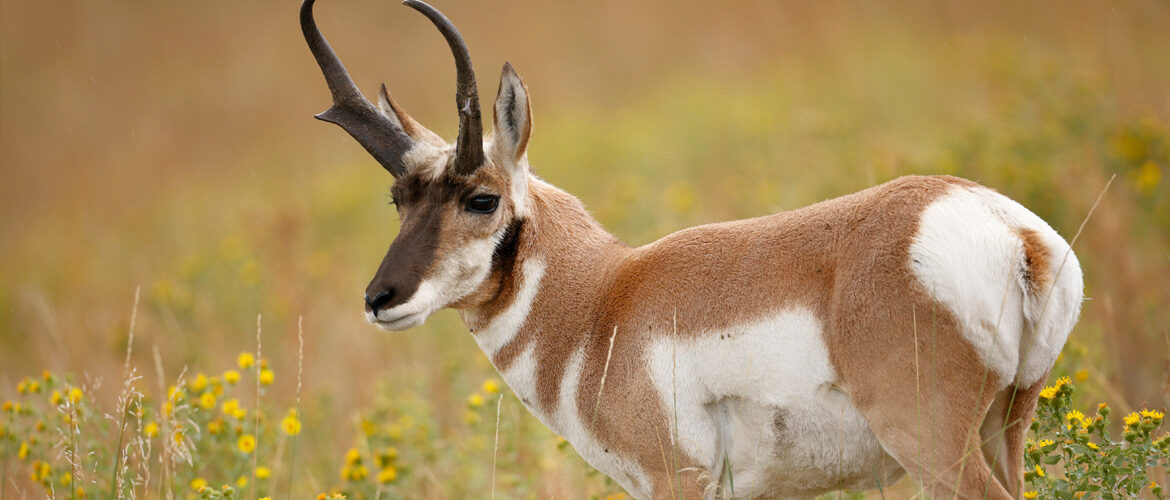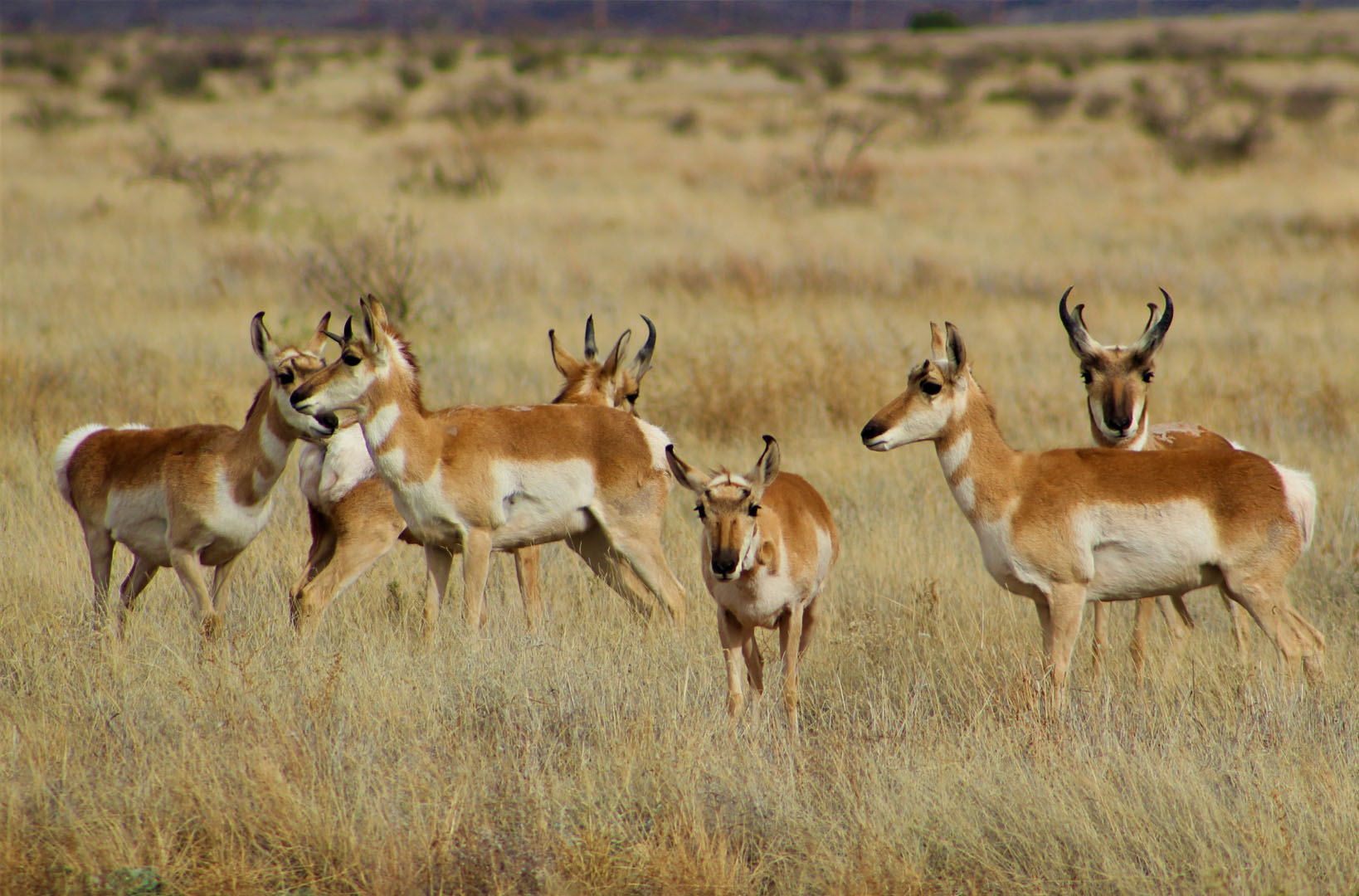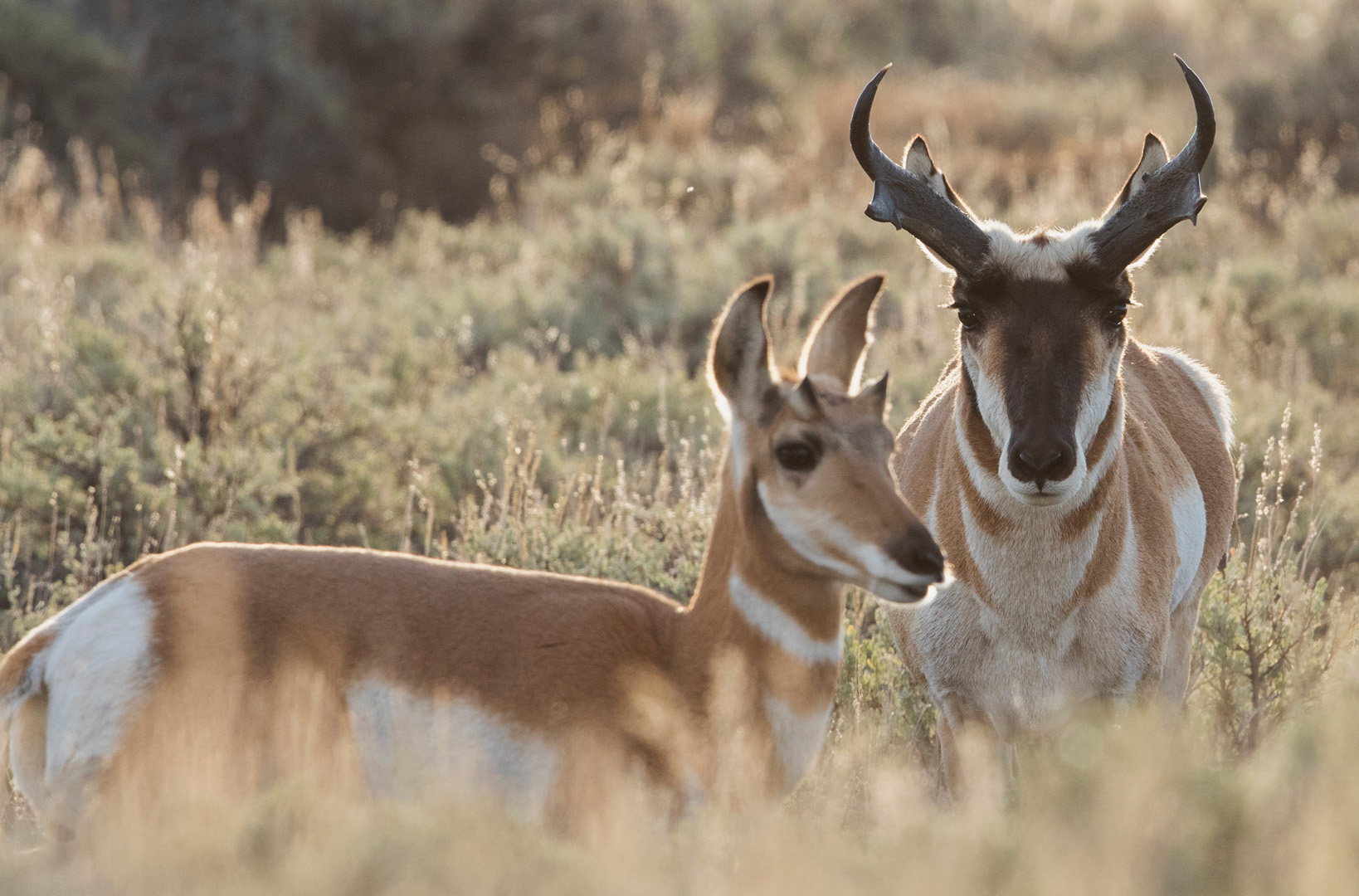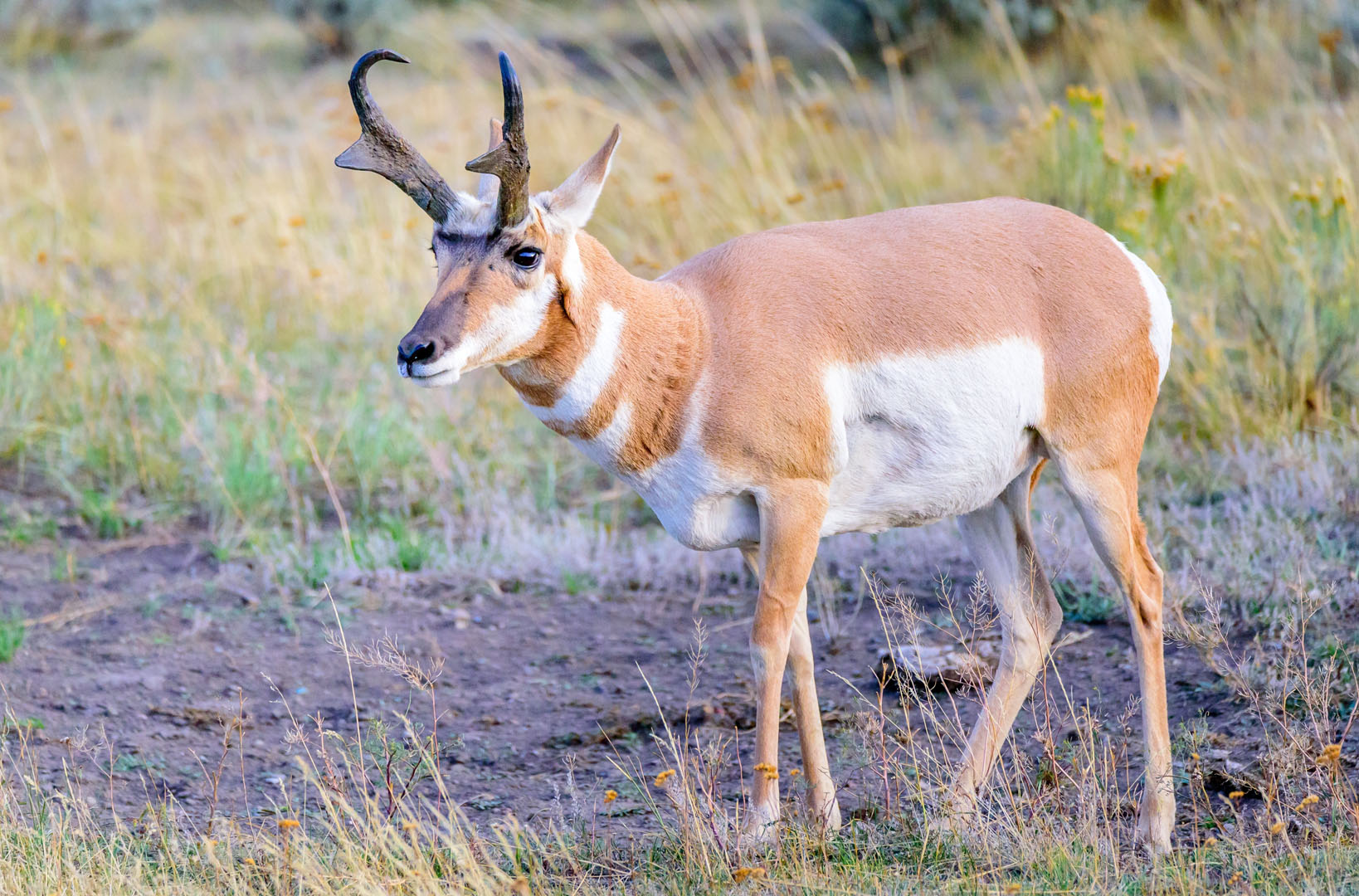$0.00
No products in the cart.

The pronghorn (Antilocapra americana) is a species of artiodactyl, meaning even-toed, hoofed mammal. Though it is not an antelope despite several names referring to it as such. The pronghorn is known in North America by many names such as the American antelope, prong buck, speed goat, pronghorn antelope, prairie antelope, or simply antelope. This is likely because it closely resembles the antelope of the Old World and fills a similar ecological niche. The pronghorn is the only surviving member of the family Antilocapridae.
The pronghorn is indigenous to western and central North America. Although first seen and described by Spanish explorers in the 16th century, the species was not recorded in any sort of formality or scrutinized until the expedition in 1804-06 by Captain Meriwether Lewis and Second Lieutenant William Clark (Woodger, E.; Toporov, B. (2004). Encyclopedia of the Lewis and Clark Expedition). The family to which the pronghorn belongs was originally divided into two subfamilies, one subfamily for extinct Miocene merycodonts and another group of all the other extinct forms plus the modern pronghorn; although it is generally thought that these distinctions are probably not valid. (Davis 2007). Debate remains over whether pronghorn belong in their own family or should be classified in Bovidae (O’Gara & Matson 1975) or in Cervidae (Janis & Scott 1987). Interestingly, recent genetic study says they are closer to Giraffidae forming a sister group to cervids and bovid. (Hernandez et al 2005; Murray 2006).

Five subspecies were named because of minor differences in color, size, and location, perhaps better referred to as ecotypes, however, mitochondrial DNA analyses since the early 1990s support the idea that there is in fact a wide-ranging species (O’Gara & Yoakum 2004):
Species that have experienced population reduction provide valuable case studies for understanding genetic responses to demographic change. Pronghorn (Antilocapra americana) were once widespread across the North American plains but were subject to drastic population reductions due to overexploitation and habitat fragmentation during the late 19th and early 20th centuries. A. a. peninsularis and A. a. sonoriensis, two pronghorn subspecies that inhabit the southern edge of the species’ distribution, are almost extinct and now breed almost exclusively in captivity (Anastasia Klimova, Adrian Munguia-Vega, Joseph I. Hoffman, Melanie Culver, Genetic diversity and demography of two endangered captive pronghorn subspecies from the Sonoran Desert, Journal of Mammalogy).
The pronghorn is the fastest land mammal in the Western Hemisphere, with running speeds of up to 90 km/h (55 mph). While it is often cited as the second-fastest land animal, second only to the African cheetah, it can sustain high speeds longer than cheetahs (Klesius, M. (2007). “Losing Ground”). University of Idaho zoologist John Byers has suggested that the Pronghorn evolved its running ability to escape from extinct predators such as the American cheetah, since its speed greatly exceeds that of extant North American predators. It has a very large heart and lungs, and hollow hair. Although built for speed, it is very poor at jumping.

The male of the species is referred to as a buck and the female a doe, young pronghorn are referred to as a fawn. The fawn is born a greyish brown colour and does will typically give birth to twins after a seven month gestation period, Twinning occurs in over 94 percent of pronghorn births. The fawn will typically be up and walking within 30 minutes of birth.
The pronghorn has a hollow hair structure, which assists them in keeping warm. Both sexes have a distinct white colouration on their rumps which flares when alarmed. The white colouration also features on the animal’s sides, breasts, bellies, and across their throats with striking black and a rusted chestnut infill.
Adult males range in size between 1.3 – 1.5 meters long from nose to tail, stand 81 –104 centimetres high at the shoulder, and weigh between 40–65 kilograms. The females are typically the same height as males, but weigh will weigh somewhere in the 34–48 kilogram range. Their feet have two hooves lending to their scientific classification, with no dewclaws.
Each horn of the pronghorn is composed of a slender, laterally flattened blade of bone which is thought to grow from the frontal bones of the skull, or from the subcutaneous tissues of the scalp, forming a permanent core. (Nasoori, Alireza (2020). “Formation, structure, and function of extra-skeletal bones in mammals”).
Over this bone core, a skin develops into a keratinous dark sheath which is shed and regrown annually. Unlike the horns of the family Bovidae, the horn sheaths of the pronghorn is branched, each sheath having a forward-pointing protrusion and hence the name pronghorn. Males will typically have a horn sheath about 12.5 – 43 centimetres (5–17 in) long with a prong while females have smaller horns that range from 3 – 15 centimetres (1–6 in) and often barely visible; the horns of the female are straight and very rarely pronged. Interestingly, the pronghorn have large protruding eyes that are amongst the largest of any North American ungulate. Those eyes provide 300 degrees of extremely good vision out to 5 kilometres.
Using this sharp eye sight, pronghorn display an enormous sense of curiosity, typically uncommon in wild animals. Pronghorn will investigate at close proximity any strange and unfamiliar object, especially one with some sort of motion. Early Native Americans learned you could lure a pronghorn in close enough for bow hunting by hiding in a bush while waving a stick or cloth and the pronghorn would draw near to see the source of the movement. When alerted to danger, pronghorn contract their rump muscles causing their white rump hairs to stand on end, which other pronghorn may detect from 3 kilometres away. At the same time, they exude a musky odour, which can be detected by other pronghorns within a 1 to 2 kilometre radius, since pronghorn also have a keen sense of smell.

Pronghorn have a distinct, musky odour that’s reported as “quite pungent”, iof which some find it. Males will mark territory with a pre-orbital scent gland which is on the sides of the head. They also have very large eyes with a 320° field of vision. The kidneys in pronghorns are quite large compared to deer and antelope, and this adaptation is likely to help remove toxins in many plant species that are poisonous to livestock and other ruminants. The enlarged kidneys may also play a role in reducing the need for water in pronghorn. Since they extract most of their water from the vegetation on which they feed, pronghorns are less dependent on water compared to white-tailed deer and mule deer. A rather significant anatomical difference in digestion between pronghorns and deer is the presence of a gallbladder, although it’s not clear as to why.
Lewis and Clark made several other observations on the behaviour of the pronghorn and how the local tribes hunted them. They described the animal, which they referred to as the “Antelope” or the “Goat” ( Guthrie, W.; Ferguson, J. (1815). A New Geographical, Historical, and Commercial Grammar and Present State of the Several Kingdoms of the World), as follows;
“Of all the animals we have seen the Antelope seems to possess the most wonderful fleetness. Shy and timorous they generally repose only on the ridges, which command a view of all the approaches of an enemy … When they first see the hunters they run with great velocity … The Indians near the Rocky Mountains hunt these animals on horseback, and shoot them with arrows. The Mandans‘ mode of hunting them is to form a large, strong pen or fold, from which a fence made of bushes gradually widens on each side. The animals are surrounded by the hunters, and gently driven towards this pen, in which they imperceptibly find themselves enclosed, and are then at the mercy of the hunters”.
The social herding behaviour of the pronghorn is similar to many deer and antelope species; however, there are some fundamental reproductive differences. The average female pronghorn will gestate for approximately six weeks longer than the average white-tailed deer. The seven to eight month gestation period in pronghorns is longer than what is typical for most North American ungulates, and it is longer than most similarly sized antelope. The longer gestation period likely accounts for the high prevalence of twin fawns in pronghorns.
Antilocaprid ancestors most likely evolved in the Old World and migrated to North American during the Late Oligocene. During the Pleistocene epoch, about 11 other antilocaprid species existed in North America and three other genera existed when humans entered North America, such as the dwarf pronghorn (Capromeryx), the Stockoceros and the Tetrameryx all of which are now extinct.
As a member of the superfamily Giraffoidea, the pronghorn’s closest living relatives are the giraffe and forest giraffe (okapi). The Giraffoidea are in turn members of the infraorder Pecora, making pronghorns more distant relatives of the Cervidae (deer) and Bovidae (cattle, goats, sheep, antelope, and gazelles), among others.

Prior to the arrival of the Europeans, the pronghorn was particularly abundant in the region of the Plains Indians and the region of the indigenous people of the Northwest Plateau and was hunted as a principal food source by the local tribes. The pronghorn has also featured prominently in Native American mythology and oral history (Bruchac, Joseph. (1992). Native American Animal Stories).
Although it is common for awareness of the buffalo, and their vast numbers in pre-settlement times across the West, few realize that the pronghorn equalled and perhaps even exceeded the bison. Immense pronghorn herds–an estimated 40 million; some say as many as 70 million–mingled with untold numbers of bison and deer, filling the American West across the shortgrass prairies (https://www.aaanativearts.com/what-is-the-cultural-significance-of-pronghorns-to-native-americans).
As late as the 1870s, a train passenger described a herd of pronghorn that stretched for seventy miles, containing an estimated one million animals. At the time when Lewis and Clark made their way to the Pacific, the pronghorn’s range was enormous, stretching west of the Mississippi River to California, north to Manitoba, and south nearly all the way to Mexico City. Just about all the tribes within its range hunted the pronghorn for meat, except the Apache, who believed it should never be hunted. Skins were used for clothing, entrails and bladders for containers and bindings, sinew for thread, and bones for tools. It was used in much the same way as deer, for all the same purposes.
The Apache have a legend that once a beautiful young woman of the tribe became a pronghorn antelope and even today her descendants still run with the wild herds of pronghorn, so the belief was, if you eat an antelope one might be eating an ancestor.

Like the bison, millions of antelope fell before both market and sport hunters. Tons upon tons of pronghorn meat filled trainload after trainload bound for the East and West coasts. Even when people couldn’t eat all the meat, pronghorn were still slaughtered. So many pronghorn were killed that the sheer quantity of meat glutted the market, making it almost worthless. In Denver during the 1860s, just twenty-five cents could buy three or four entire pronghorn carcasses – a single coin for many kilos of wild game meat. Sometimes, hunters couldn’t even give the meat away. Despite this, pronghorn continued to be routinely shot by the thousands and the carcasses simply left on the prairie to rot. Ranchers feared they would take away forage from their sheep and cattle, not realizing neither eat the plants that pronghorn do. Like the bison, within just a few decades, hunters, farmers, and ranchers virtually wiped out a species that had been a part of the North American continent for nearly 20 million years. By the early 1900s the pronghorn had vanished from most of the West (www.aaanativearts.com/what-is-the-cultural-significance-of-pronghorns-to-native-americans). However, recent conservation efforts and the reduction in wild animal exploitation across the U.S has resulted in a rebounding response by the hearty American icon and although the animal is likely not at the point of population it once was, their numbers are stable and well managed,
Hunting opportunities are so accessible that one could well be overwhelmed with options. If you’ve never done a Western U.S spot-and-stalk hunt, then the pronghorn will whet your appetite with what can be a a very fun, open hunt with lots of opportunity on animals. This carries across well as a primer for Western mule deer and maybe even an elk hunt. Additionally, success rates on pronghorn hunts average much, much higher than other big game species (sometimes higher than 90%!). This means it’s likely you’ll get a good chance at connecting on a decent animal. Options, as with everything in the U.S, are varied and the keen hunter doing their homework can build points in multiple Western States for great DIY opportunities at world class trophies, these tags can also be used with a guiding option which is great for the hunter who is short on time or worried about executing the whole process alone. Landowner tags are available although do typically come at an added cost.